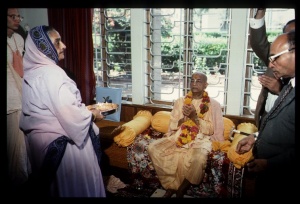SB 4.23.16

A.C. Bhaktivedanta Swami Prabhupada
TEXT 16
- khāny ākāśe dravaṁ toye
- yathā-sthānaṁ vibhāgaśaḥ
- kṣitim ambhasi tat tejasy
- ado vāyau nabhasy amum
SYNONYMS
khāni — the different holes in the body for the sense organs; ākāśe — in the sky; dravam — the liquid substance; toye — in the water; yathā-sthānam — according to proper situation; vibhāgaśaḥ — as they are divided; kṣitim — earth; ambhasi — in the water; tat — that; tejasi — in the fire; adaḥ — the fire; vāyau — in the air; nabhasi — in the sky; amum — that.
TRANSLATION
In this way, according to the different positions of the various parts of the body, Pṛthu Mahārāja merged the holes of his senses with the sky; his bodily liquids, such as blood and various secretions, with the totality of water; and he merged earth with water, then water with fire, fire with air, air with sky, and so on.
PURPORT
In this verse two words are very important: yathā-sthānaṁ vibhāgaśaḥ. In Śrīmad-Bhāgavatam, Second Canto, Fifth Chapter, Lord Brahmā clearly explained to Nārada how the creation took place, and he explained one step after another the proper divisions of the senses, the controller of the senses, the objects of the senses, and the material elements, and he also explained how they are created one after another: the air from the sky, the fire from the air, the water from the fire, the earth from the water, etc. It is important to know thoroughly the process of creation as it applies to this cosmic manifestation. Similarly, this body is also created according to the same process by the Supreme Lord. The Personality of Godhead, after entering the universe, creates the cosmic manifestations one after another. Similarly, the living entity, after entering a womb of a mother, also collects his gross and subtle bodies, taking ingredients from the totality of sky, air, fire, water and earth. The words yathā-sthānaṁ vibhāgaśaḥ indicate that one should know the process of creation and should meditate upon the creative process inversely and thus become free from material contamination.